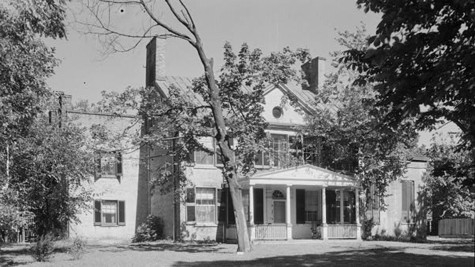 Friendship House. The Maples. Duncanson House. Whatever name you use to refer to the mansion on the 600 block of South Carolina, you know that George Washington referred to it as “a fine house in the woods.” After all, it says so on the sign out front, the American Institute of Architects has been saying this since at least their 1974 guide to DC houses, and, in 1956, Dorothea Jones, in her book “Washington is Wonderful” wrote the same. Unfortunately, it appears that for over 50 years, a major falsehood has been spread about this house.
Friendship House. The Maples. Duncanson House. Whatever name you use to refer to the mansion on the 600 block of South Carolina, you know that George Washington referred to it as “a fine house in the woods.” After all, it says so on the sign out front, the American Institute of Architects has been saying this since at least their 1974 guide to DC houses, and, in 1956, Dorothea Jones, in her book “Washington is Wonderful” wrote the same. Unfortunately, it appears that for over 50 years, a major falsehood has been spread about this house.
There are only a little over three years during which Washington could have seen this house and commented on it: Between the Duncanson’s moving in to the Maples in Summer 1796 and Washington’s death in December 1799. The ex-President did indeed visit the Federal City (as he always referred to it) numerous times in that time-frame, but makes no indication of having met Mr. Duncanson, owner of The Maples, nor stopping at his home.
Washington usually passed through his eponymous city on the way to and from Philadelphia. He would normally stop in Bladensburg, then proceed straight on to Georgetown. Later, after he had hired William Thornton, architect of the Capitol, to build him a pair of houses just north of the Capitol, Washington would occasionally venture into the city to see how the work was progressing.
In all these cases, he mentions only a small set of places that he dined or lodged: Chiefly among them Mr. Law, who owned the land at the confluence of the Anacostia and Potomac and had been a friend, or at least business-acquaintance of Duncanson, until the two had a major disagreement in 1796. Thomas Peters and the Union Tavern in Georgetown are also mentioned by Washington. Finally, his architect, Mr. Thornton, was occasionally Washington’s host.
Now, absence of evidence does not imply evidence of absence, but there really doesn’t seem to be any time in which Washington might have made his visit. Nonetheless, this story must have come from somewhere (even if it is simply the imagination of Ms. Jones) and the question arises: If Washington never visited The Maples, who did call it a “fine house”? (an expression that Washington himself never put to paper about any dwelling)
The 1901 book “Greenleaf and Law in the Federal City” by Allen Culling Clark gives a clue. In it Mr. Clark quotes a Mr. Watterston, who describes “Capn Duncanson” as having “built a fine brick house in the woods between the Capitol Hill and Navy Yard.” Watterston’s full name was George Watterston, and he was the third librarian of Congress. After having been heaved out of office for being loudly of the wrong political party when Andrew Jackson took over the presidency, Watterston spent his time writing books and attempting to get his old job back.
One of these books was a history of Washington (which could hardly have been terribly long, as the author had died in 1854, when the Federal City was not yet even of retirement age) and it was here that Watterston wrote of Duncanson’s house. The book was never published, but somehow the manuscript made its way into Allen Clark’s hand, for him to use it in his book.
Nine years after his book was published, Clark gave a speech before the Columbia Historical Society on Duncanson himself. He once again quoted Watterston, though this time changed the quote to “a fine house in the woods between the Capitol Hill and Navy Yard.” It is this wording that Dorothea Jones used 46 years later. Somewhere in there, a lie had been set into the world, a lie that keeps getting repeated to this day.


You broke my heart. This was a fine myth to believe about that house. I wish I could unread your fine report.
Actually, George Watterston’s guide book to Washington DC was published in 1840. Watterston himself was a long time resident of DC (his last home is on 2nd Street across from the Madison Bldg) and very knowledgeable about the doings of its denizens.